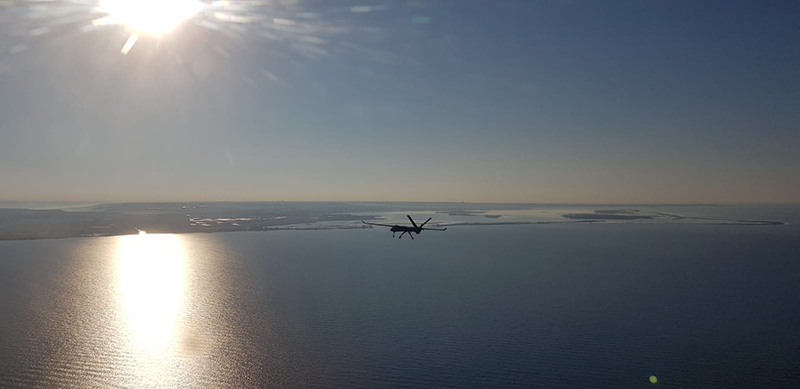23 April 2021
The Uncrewed Air System (UAS) surveillance sector is a core business for Leonardo, which is currently the only company in Europe offering a complete UAS package, including aircraft, sensors, mission system and control station.
In 2013, Leonardo became the first company in the world to provide UAV systems supporting a civilian international organisation, and is the only European manufacturer to offer Medium Altitude Long Endurance (MALE) class remotely piloted systems.
These are just some of the significant achievements in a long success story in the field of Remotely Piloted Aircraft Systems (RPAS), in which Leonardo has boasted autonomous design and production capacity since the design and production of first generation of MIRACH target drones in the 1970s. These early systems evolved into the first remotely controlled reconnaissance aircraft, and, since 2003, into the FALCO, a UAS specifically designed for surveillance.
The FALCO is the ancestor of the entire family – a tactical UAS capable of flying at altitudes of more than 6,000 metres with an autonomy of around 13 hours. Used in security and armed forces operations, the FALCO is designed to collect information and identify targets in real time, guaranteeing complete awareness of the scenario with a load capacity (or available payload) of more than 100kg, which may be used to carry optical and radar sensors. The FALCO now flies regularly in real-life operations serving a number of international clients, with more than 60 currently in operation, even under extreme weather conditions.
In 2012, Leonardo began developing the FALCO EVO, a “heavy” tactical version of the aircraft, initially as an upgrade kit for the FALCO, with both featuring the same engine and avionics.
The EVO’s wingspan was increased from 7.2 to 12.5 metres, thereby improving its aerodynamic efficiency and the amount of fuel that could be carried. The engine was then replaced with a new turbocharged high-efficiency Heavy Fuel version, guaranteeing better performance under all environmental conditions, including base altitude, humidity and high temperatures.
The FALCO EVO, flown for the first time in 2018, can fly higher than 6,000m for more than 20 hours in a row (about 18 hours when fully loaded). Its payload can exceed 150kg, permitting a choice of various combinations of high-performing sensors, including AESA PICOSAR radar and GABBIANO T20-UL multi-mode radar. The FALCO EVO is the only European UAV in its category to be exported and used by several international clients, with whom it has already accumulated tens of thousands of flight hours. Most of these hours were conducted as part of the UN MONUSCO mission, in which the EVO version replaced the basic FALCO in 2019. Since 2018, the EVO has also been flying in Europe, supporting maritime surveillance, beginning with the European FRONTEX mission.
Within civilian airspace specifically, the FALCO and FALCO EVO have now totalled about 8,500 flight hours, including in unsegregated airspace. This figure is unmatched by their competitors.

The latest addition to the FALCO family is the XPLORER, with its features putting it in the MALE category despite its small size. Its maximum weight at take-off is 1.3t, with an 18.8m wingspan, a payload capacity of more than 350kg and more than 24 hours of flight autonomy when fully loaded, even at altitudes over 9,000m. The aircraft can perform a vast range of tasks, from surveillance to maritime patrolling, anti-piracy operations and border defence. While conceptually derived from its predecessor, the XPLORER is a completely new kind of machine in terms of systems and aerodynamics. Its mission system draws on the experience of Leonardo’s advanced, flexible, open architecture airborne mission management system, ATOS, and represents an evolution of the SKYISTAR that is also installed on higher-class RPAS, while the main sensor is the GABBIANO T80-UL surveillance radar. The aircraft is largely customisable, however, drawing on the vast range of data-gathering sensors and suites produced by Leonardo, such as a LEOSS electro-optical tower, as well as third-party catalogues.
The Ground Control Station, which largely re-uses the principal components and subsystems of the previous versions, has also been completely redesigned. XPLORER's maiden flight took place in 2020, and the test campaign is still underway. Initial operative capacity should be declared by the end of 2021, reaching full maturity in 2022.
The Italian Air Force is fully involved in the qualification process with DAAA and the Italian Flight Test Wing (GSV). In particular, GSV have provided the Flight Test Engineer and the experimental pilot for the "Maiden Flight".
Falco Xplorer seems to be well placed in the European domestic market as well as in the international market.
The FALCO family clearly stands out for its innovative technology, but Leonardo has combined this with an equally innovative business model.
In response to the changing needs of the market, Leonardo has decided that FALCO’s surveillance capacity will also be offered in the form of a “turnkey” service. In this mode, the aircraft and its operations are managed entirely by Leonardo, simply supplying the client with the data set and information resulting from the mission.
This gives the FALCO a unique position in the market, extending business opportunities into a number of interesting areas.

